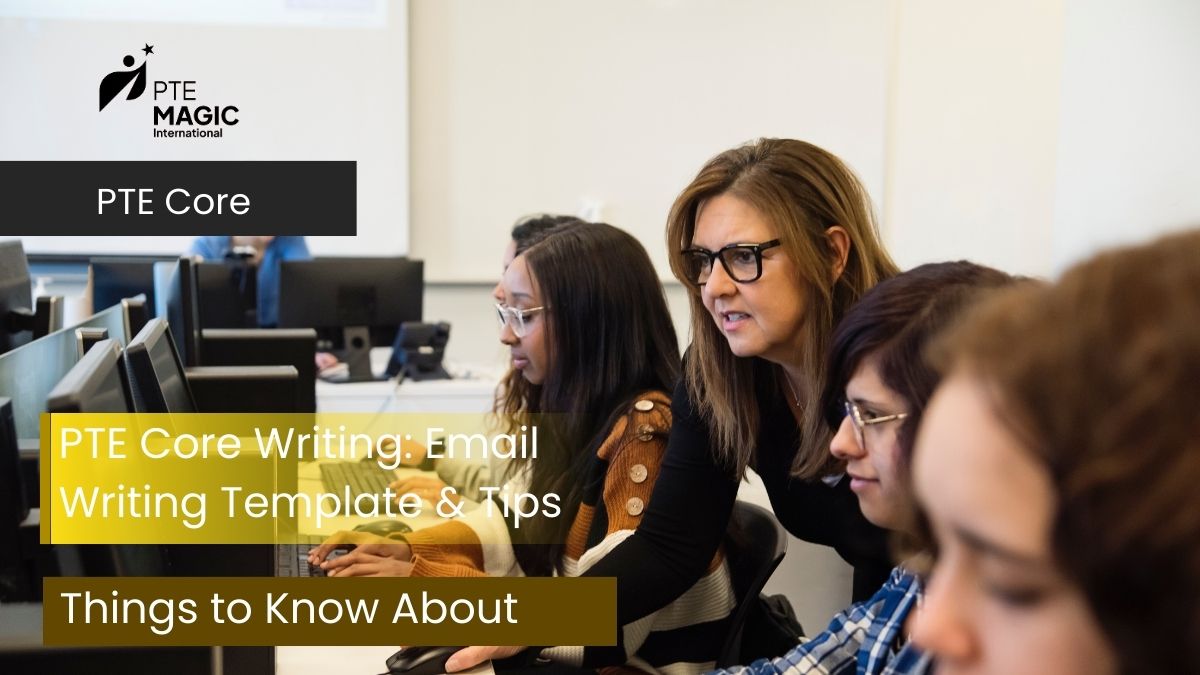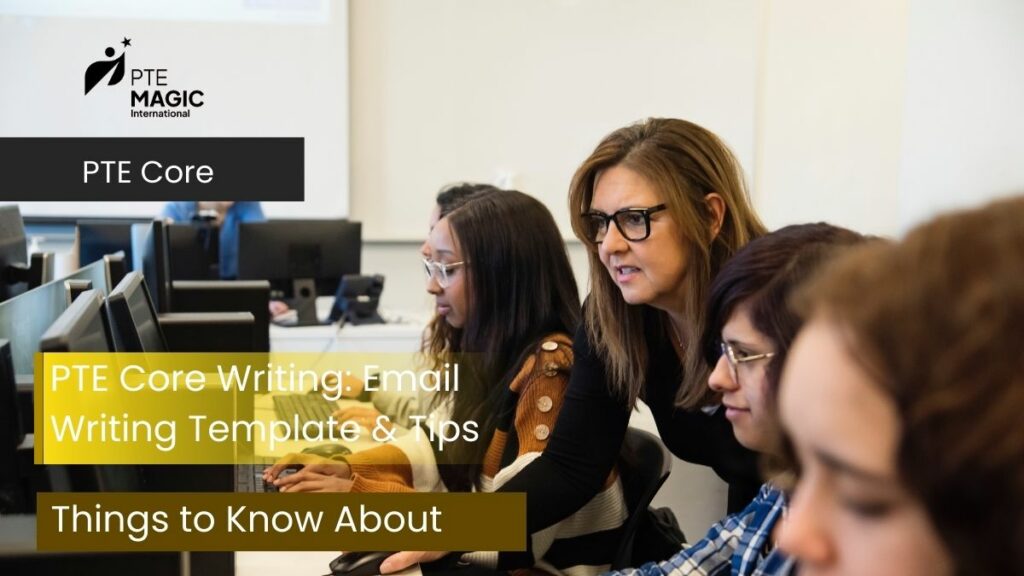No courses in the enrolment list.
Good writing is not enough to get a high PTE Core Writing Email score. PTE Core test-takers must also know what to write and how to structure their email correctly.
Led by a seasoned PTE teacher with years of experience, our team is dedicated to helping students overcome challenges and achieve PTE success. Their commitment and expertise have helped many students reach their desired scores.
This blog by PTE Magic explains the task format and scoring system for beginners. We also provide templates for common topics and tips to master the task. Our teaching methods are continually refined to provide personalized attention and the best possible support, ensuring every student’s success drives our approach.
Join our community to benefit from the expertise and support that fuels students’ success.
Check them out below!
Key Takeaways
- You must read the given text and write a response email between 80 and 120 words in the PTE Core Email Writing task.
- Knowing the topics and templates will significantly benefit your PTE Core preparation.
- The templates and tips provided in this blog can help you effectively plan your PTE Core Writing Email practice and achieve your desired scores in the exam.
Related:
PTE Core Email Writing Format

In the PTE Core Email Writing task, you must read the given text and write a response email between 80 and 120 words. Pearson gives test-takers 9 minutes to finish this task. A word count is displayed at the bottom of the screen to help you track your writing.
Test-takers can use cut, copy, and paste buttons while writing.
The PTE Core Email Writing task evaluates your ability to identify the main ideas in a paragraph and express those ideas effectively. Reading, writing, grammar, and vocabulary are the critical components of this task.
How is PTE Core Email Writing scored?
When preparing for the PTE exam, understanding its overall scoring system is crucial for achieving a high score. Consider these seven factors that affect your PTE Core Email Writing score, especially in the pte core write task, which is assessed based on specific criteria:
- Content: You will achieve high scores if your email is on-topic and covers all points of the given text. You won’t receive any scores in all seven factors if you don’t mention the prompt.
- Form: The required length is between 80 and 120 words. Test-takers will get full credit if their writing stays within this range. Emails that are too short or too long will have lower scores.
- Email conventions: A correct email format includes a greeting, an introduction, a conclusion, and a farewell. Your score drops when your email is missing any of these parts.
- Grammar used: Your score is based on your written English. Test-takers with good sentence structure, punctuation, and grammar will receive higher scores.
- Organisation: Being well-structured is another factor determining your writing scores. Organise your ideas logically while closely following the purpose of the email, which shows an exemplary structure. This is the type of email that has good scores.
- Spelling: Test-takers must use only one spelling style throughout their emails. For example, if you use American English, stick with it throughout.
- Vocabulary: A wide vocabulary range will help you score higher. Therefore, use various words suitable to the email context.
PTE Core Email Writing Practice
Practice builds confidence. With practice, test-takers will be familiar with the test format. To achieve the best results, students should continually improve their writing skills through regular practice and feedback.
Knowing the topics and templates will significantly benefit your PTE Core preparation.
PTE Core Email Writing Topics
The PTE Core test doesn’t have fixed Email Writing topics. Test-takers will encounter multiple topics in real-life settings. However, based on the previous PTE Core tests, PTE Magic has concluded the topics that often appear in the test, including:
- Workplace communication: These emails are usually addressed to your coworker or boss. The email content is mainly related to an issue or update at work.
- Customer service: Sometimes, test-takers might need to write a response email to a customer to answer their complaint or questions.
- Event organisation: In this type of email, you will write to inform a group of people about an upcoming event.
- Academic communication: Professor or classmates are the subjects that you will respond to. These emails are typically related to projects or assignments. Strong email writing skills in these contexts can also support applications for permanent residency, as clear communication is often required for such processes.
- Personal communication: Test-takers will write an email regarding personal matters to their friends or family members.
PTE Core Email Template Examples
Template for workplace communication emails
Scenario*:*
Your coworker, Michael, is concerned about the recent changes in the project deadlines. Write an email to Michael, providing suggestions on how to manage the deadlines effectively. [100 words]
Your response must address the following three points:
- encourage the project goals
- time management tips
- offer for help
You should include all three points. Provide supporting ideas for your email.
Example response:
Dear Michael,
I hope this email finds you well. I understand your concerns about the recent changes in the project deadlines. Therefore, I want to offer suggestions that might help you manage the deadlines effectively.
First, remember that our primary goal is unchanged. We focus on delivering high-quality results. Although the deadlines have shifted, focusing on excellence will guide us through.
My advice for efficient time management is to divide your tasks into smaller parts and prioritise them based on urgency. You will organise your tasks better, which also reduces your stress.
Moreover, I am willing to assist you with any challenging tasks. I believe teamwork and support can suppress the pressure of your deadline.
Let’s work together to handle these changes and ensure success for our projects.
Best regards,
[Your Name]
Template for customer service emails
Scenario:
A customer, Jane Smith, has complained about a delivery delay in her recent order. Write an email to address Jane’s complaint, explaining the reason for the delay and offering a solution. [100 words]
Your response must address the following three points:
- apology for the delay
- explanation of the delay
- solution
You should include all three points. Provide supporting ideas for your email.
Example response:
Dear Ms. Smith,
I am writing to apologise for the delivery delay of your recent order. I sincerely regret any inconvenience this issue has caused.
For your dearest information, your order regrettably cannot arrive in time due to unforeseen issues with our supplier that have affected our shipping schedule. We are utterly sorry and are trying our best to solve this issue to prevent future delays.
To compensate for this inconvenience, we are offering a 10% discount on your next purchase. We appreciate your patience and understanding.
Thank you for your continued support.
Best regards,
[Your Name]
Scenario:
A customer, Mark Lee, is requesting a full refund for a defective product from his recent purchase. Write an email to address Mark’s complaint, apologise for the defective product, and explain the process for issuing a full refund. [100 words]
Your response must address the following three points:
- apology for the defective product
- confirmation of the recent purchase and issue
- explanation of the full refund process and prompt attention to the request
You should include all three points. Provide supporting ideas for your email.
Example response:
Dear Mr. Lee,
I am very sorry to hear that the product you recently purchased was defective. Please accept our sincere apologies for any inconvenience this has caused.
We have confirmed your recent purchase and understand your request for a full refund. We are currently processing your refund and will ensure it is completed as soon as possible.
Your request is receiving our prompt attention, and you can expect a prompt response with confirmation once the refund is issued. Thank you for bringing this to our attention and for requesting a resolution.
Best regards,
[Your Name]
Template for event organisation emails
Scenario*:*
You are planning a team-building event for your company. Write an email to your colleagues informing them about the event. [100 words]
Your response must address the following three points:
- event date
- location of the event
- activities planned
You should include all three points. Provide supporting ideas for your email.
Example response:
Dear Team,
I am excited to inform you about our upcoming team-building event. The expected date and time is 2 pm this Friday, June 15th and I propose we hold this event at Greenfield Park.
This event aims to increase our company bonding and create a fun and healthy work environment. I have planned various activities, including team challenges, outdoor games, and a BBQ lunch.
I believe this would be a great chance for everyone to enjoy some time outside the office. Please organise your schedules so we can enjoy our best
“Work hard, play hard”. Looking forward to seeing you all there!
Best regards,
[Your Name]
Template for event academic communication emails
Scenario:
Your professor has assigned a group project due at the end of the month. Write an email to Mr. Harold, your professor, to request an extension for the project deadline and explain the reasons. [100 words]
Your response must address the following three points:
- current progress
- challenge faced
- new deadlines
You should include all three points. Provide supporting ideas for your email.
Example response:
Dear Dr. Harold,
I am [Your Name] from the D group in your Economics class. I am writing on behalf of my group to request an extension for our project deadline.
While we have finished ¾ of our assignments, we encountered some unexpected technical issues during the project period that have slowed our progress.
We are highly concerned about meeting the deadline on June 15th, so we would like to request an extension of one week, which will be on June 22nd. This additional week will help us resolve the issues and finish the project to the best of our abilities.
Thank you for considering our request. We are looking forward to hearing from you soon!
Best regards,
[Your Name]
Scenario:
You recently attended a workshop and are requesting a certificate of participation from the event organiser. Write an email to request the certificate and mention the event you recently attended. [80 words]
Your response must address the following two points:
- mention the event you recently attended
- clearly state you are requesting a certificate
You should include both points. Provide supporting ideas for your email.
Example response:
Dear Event Organiser,
I hope this message finds you well. I am writing to confirm my participation in the “Digital Marketing Workshop” that I recently attended on May 10th. I am requesting a certificate of participation for this event, as it will be valuable for my academic records.
Thank you for your assistance, and I look forward to your response.
Best regards,
[Your Name]
Template for event personal communication emails
Scenario:
Your friend is planning a trip to visit you next month. Write an email to Alex, your friend, to provide details about your hang-out date. [100 words]
Your response must address the following three details:
- best time to visit
- suggested activities
- necessary preparations
You should include all three points. Provide supporting ideas for your email.
Example response:
Dear Alex,
I hope you’re doing well. I’m so excited to hear you plan to visit next month. Before you go, I want to share a few things to help you prepare for your trip.
The second week of June would be the ideal time to visit, as it is the beginning of the summer vacation season. You will be surprised by the variety of services here. We can hang out in the city, visit local museums, and even go on a food tour.
Please wear comfortable shoes for our date, as we will walk a lot! Also, if you have any beverage preferences, let me know so I can stock up on your favourite drinks.
Looking forward to seeing you soon!
Best regards,
[Your Name]
Note:
An informal email is typically written in a casual, friendly tone and may include conversational greetings, personal touches, and relaxed language. For example, an informal email to a friend might start with “Hey Alex!” and include updates about your life, jokes, or plans, rather than formal phrases or structured requests.
Types of Emails in PTE Core
In the PTE Core exam, test takers will encounter a variety of email types, each requiring a different approach and tone. The two main categories are formal and informal emails.
Formal emails are used in professional or official contexts, such as writing to a customer service team, a council member, or a professor.
These emails require a polite and respectful tone, clear structure, and adherence to standard email conventions.
On the other hand, informal emails are written for personal or social purposes, such as communicating with friends or family members. These can be more relaxed in tone and style.
Understanding the differences between these types is essential for PTE Core email writing success.
- For formal emails, always use appropriate greetings (like “Dear Ms. Smith” or “Dear Mr. Lee”), maintain a professional tone, and close with phrases such as “Best regards” or “Kind regards.”
- For informal emails, greetings and closings can be more casual, but clarity and organization remain important.
By recognizing the type of email required in the task, test takers can tailor their writing to score higher and demonstrate their understanding of effective communication in the PTE Core exam.
PTE Core Email Writing Tips
Understand The Task
Before you start writing, read the task carefully and note the keywords in the given text to better understand the requirements. Test-takers must ensure the recipient, which will decide their writing tone.
Next, determine the purpose of your email. It’s important because it helps define your writing structure. As seen from the sample templates, an email addressing the concern has a different structure from a making-a-suggestion email. Therefore, understanding the purpose of the email helps you format your writing correctly.
Recognise Key Details
After you understand the task’s requirements, find out the details to include in your email. The task typically provides three bullet points to address.
Test-takers should mention all three points to score well. Additionally, adding relevant details and supporting ideas for each point contributes to your PTE writing score.
Structuring Your Email
In addition to scoring points, mentioning the key details helps to organise and structure your email effectively.
Test-takers should start with a brief introduction explaining the email’s purpose. Next, plan to write each bullet point in separate paragraphs. Your score will be higher if you provide related examples and logical explanations. Last, conclude your email with one or two sentences to express your gratitude and farewell.
This email structure helps test-takers create easy-to-follow writing and better organise their email content.
Email Task Requirements
The PTE Core email writing task challenges test takers to write an email in response to a specific scenario provided in the prompt. Each prompt outlines a situation and lists key details or points that must be addressed in the response.
To achieve a high score, test takers should write an email that is well structured, includes a clear introduction, body, and conclusion, and follows proper email conventions.
It is important to use the correct email format, starting with a greeting such as “Dear Ms.” or “Dear Mr.”, and ending with a closing like “Best regards” or “Kind regards.”
The body of the email should address all required details and provide supporting ideas for each point. Staying within the required word count is also crucial.
Test takers should ensure their writing is free from grammatical errors and that their ideas are logically organized.
By carefully following these requirements, you can write an effective response that meets the expectations of the PTE Core email writing task.
Time Management for PTE Core Email Writing
Effective time management is a key factor in achieving success in the PTE Core email writing task. With only 9 minutes to complete the task, test takers must use their time wisely.
Start by reading the prompt carefully to identify the key points that need to be addressed. Take a moment to plan your response, deciding on the main ideas and the order in which you will present them.
Once you have a plan, start writing your email, making sure to cover all the required points.
Leave a minute or two at the end to review your work, check for errors, and ensure you have met the word count.
Practicing under timed conditions before the exam can help you develop the skills needed to manage your time effectively during the real test.
By focusing on the key points and following a clear plan, you can complete the PTE Core email writing task confidently and efficiently.
Using Vocabulary and Collocations Effectively
To score well in the PTE Core email writing task, it is important to use a wide range of vocabulary and appropriate collocations. Collocations are word combinations that commonly go together, such as “kindly request,” “greatly appreciated,” or “provide supporting ideas.”
Using these naturally in your writing can make your email sound more fluent and professional.
Test takers should select vocabulary that fits the context of the email—formal words for professional situations and more relaxed language for informal emails.
Avoid using words that are too formal or too casual for the given scenario.
Incorporating relevant vocabulary and collocations not only helps you express your ideas clearly but also demonstrates your language proficiency to the examiner.
By practicing with different topics and paying attention to how words are commonly used together, you can significantly boost your writing skills and increase your chances of PTE Core exam success.
Final Thoughts
With the templates and tips provided in this blog, PTE Magic hopes to assist you in effectively planning your PTE Core Writing Email practice. Visit our website for quality PTE courses and learning resources to achieve high scores in PTE!
FAQs
What email structure scores best?
Use a clear structure: greeting → purpose sentence → one paragraph per bullet point with supporting detail → polite closing and farewell. This helps Content, Organisation, Email Conventions, Grammar.
Do I need to address every bullet point in the prompt?
Yes. Missing a point hurts Content and Organisation, and can significantly reduce your total score.
Is it okay to use contractions (e.g., “I’m”, “don’t”)?
Yes, but match the tone. Prefer full forms in formal emails; contractions are fine in informal ones.
What tone should I use if I’m unsure whether it’s formal or informal?
Default to polite and neutral. Avoid slang, emojis, and overly casual phrases if the relationship or context isn’t clearly personal.
What common mistakes lower scores?
Missing a bullet point, exceeding/under-shooting word count, mixing spelling styles, weak paragraphing, overly casual tone in formal contexts, and grammar/punctuation slips.
Last updated on 11/10/2025

My name is Moni, and I am a seasoned PTE teacher with over 6 years of experience. I have helped thousands of students overcome their struggles and achieve their desired scores. My passion for teaching and dedication to my student’s success drives me to continually improve my teaching methods and provide the best possible support. Join me on this journey toward PTE success!


























I am a firm believer that the best teachers educate with their hearts not just their minds.
Moni | PTE MAGIC International Founder
Explore PTE
Tips & Tricks
When does Canada approve the PTE Core test? Find the answer in this blog. We...
Read more →Want to achieve high PTE Core Write From Dictation scores with proper practice and tips?...
Read more →Discover the PTE Core Highlight Incorrect Words task’s format, scoring system, tips, and more in...
Read more →